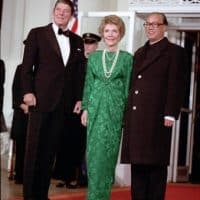After the destruction and horrors of World War II, countries across the world banded together to offer support and assistance. Some of these alliances would last, such as the United Nations, but others would not, like the Eastern Bloc. The Eastern Bloc has its beginnings in the early 1920s, when a treaty formed the Union… Read More "Construction of the Eastern Bloc Through a Woman’s Eyes"
Have you ever seen a monkey in an airport? How about the Dalai Lama? Have you visited the world’s first judo dojo in Japan? George Herrmann, who served in the Department of State as a full-time Security Engineering Officer (SEO) for over twenty years, has done all this and more. Herrmann fixed locks and doors,… Read More "George Herrmann’s Excellent Adventures in West Africa, South America, East Asia, and More"
Haiti has been plagued with instability for much of its existence, despite being the second country in the Americas to declare independence. The U.S. and United Nations (UN) have been involved in Haiti since 1993 as a multinational force, peacekeeping mission, and crisis response network. However, the creation of a long-lasting secure government has eluded… Read More "Lessons from Haiti: Why Security-Only Interventions Fail"
With a presidential visit comes months of preparation and stress. While big embassies with hundreds of staff members are often old hands at orchestrating big diplomatic events, it is not the same for small consulates. Such was the case when President Reagan and around 1,000 people, including 300 journalists, visited the small U.S. consulate in… Read More "A Big Delegation For a Small Consulate: President Reagan visits Shanghai"
Next to Pearl Harbor and 9/11, the Iranian seizure of the U.S. Embassy in Tehran on November 4, 1979 and the detention of fifty-two American diplomats for 444 days constituted the most consequential foreign attack on the United States in modern American history. Mark Feldman’s oral history provides a riveting account of the fraught diplomacy… Read More "The Iran Hostage Crisis: Diplomatic Drama and Legal Innovation"
The Passing of Charles Stuart “Stu” Kennedy
We are saddened to share the news that Charles Stuart “Stu” Kennedy died on Sunday, January 2. As Jim Dandridge notes, one is never prepared for the passing of a professional colleague and friend. Stu was and is a pillar of ADST’s excellence. We are grateful that we were able to celebrate Stu and his… Read More "The Passing of Charles Stuart “Stu” Kennedy"
A Look Back—First Director of the Population, Refugees, and Migrations Bureau
The Biden administration nominated Ambassador Julieta Valls Noyes to serve as assistant secretary of state for the department’s Bureau of Population, Refugees, and Migration (PRM). A career diplomat, Noyes previously served as deputy assistant secretary of the Bureau of European and Eurasian Affairs, where she managed relations between Western Europe and the EU from 2014… Read More "A Look Back—First Director of the Population, Refugees, and Migrations Bureau"
A Dramatic Turning Point: Turkey’s Last Pride Parade
On the same day that the United States Supreme Court legalized same-sex marriage, US diplomat Chuck Hunter witnessed police forces violently crack down on a peaceful celebration of LGBTQ+ rights in Istanbul—essentially Turkey’s last legal pride parade. The annual pride parade in Istanbul, which had been going for decades, had been the largest in the… Read More "A Dramatic Turning Point: Turkey’s Last Pride Parade"
The Fall of Saigon — April 30, 1975
April 30, 1975 will long be remembered as the day that Saigon fell and with it, the end of U.S. involvement in Vietnam. It also marked the beginning of Vietnam’s unification as a “socialist republic.” North Vietnamese forces began their final attack on Saigon on April 29, with a heavy artillery bombardment. This bombardment at the… Read More "The Fall of Saigon — April 30, 1975"





